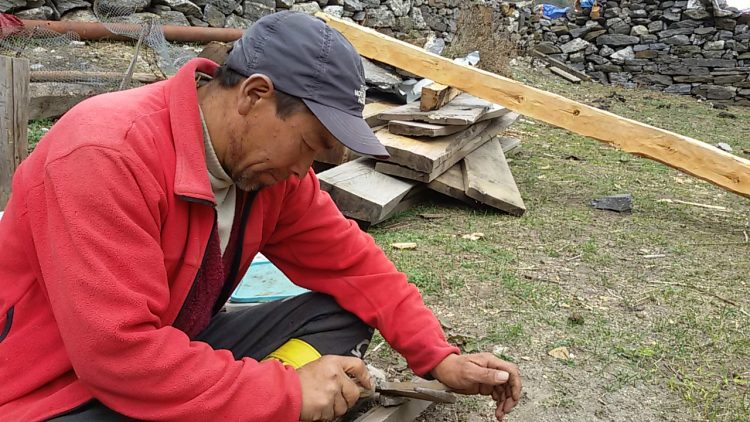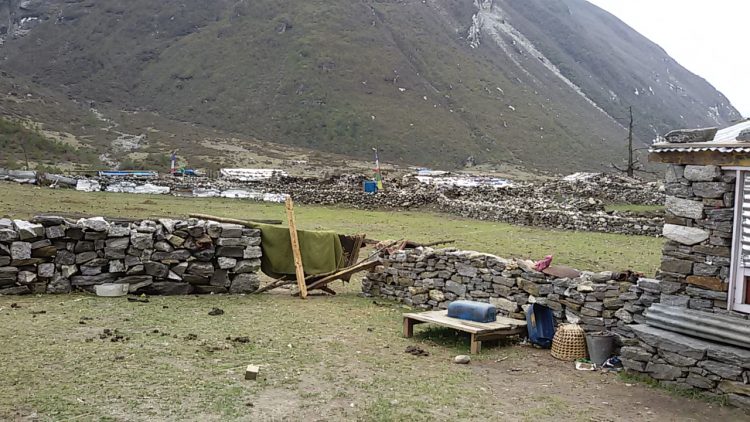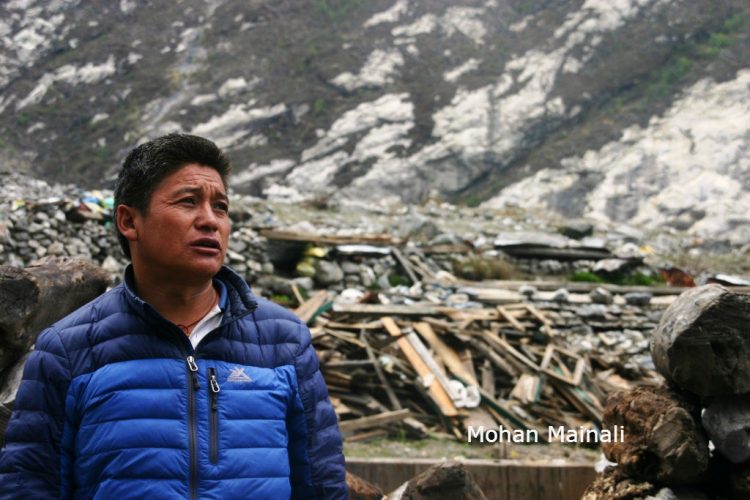Struggling to rise from the ruins
Mohan Mainali / June 20, 2016

Chhime Tamang whets a sickle on the frontyard of his house along the Langtang-Kyanjing trail. The picture was taken in May first week. Photo: Mohan Mainali
Singdum village of Langtang Valley is not so far from the Kathmandu. It is to the north of Kathmandu Valley, 50 kilometers as the crow flies. But we took the land route – Kathmandu to Dhunche by vehicle and then onward on foot – and it took us four days to reach there.
During this time, one would see rock-walled small terraces. By mid-May, the Karu plants [naked barley] in these terraces would be around a foot tall. And the Karu leaves would be swaying in the afternoon winds. Little potato plants would have appeared above the grey ground.
But this time nothing like that was there. The rock walls around the terraces had collapsed. Barring a few, most of the terraces were fallow.
This is the second year that Singdum has been like this. Last year, the farmers had rebuilt the walls around their terraces. They had sowed naked barley and planted potatoes. Immediately after the April 25 earthquake, a huge avalanche hit Singdum. The rapid avalanche had the speed of around 300 km per hour. It was very powerful and scattered the rocks of the walls across the terraces. The snow deposit was thick, so it took a long time to melt away. As a result the snow destroyed the crops underneath.
Singdum remained deserted for around six months. Now this place is attempting to find its feet.

Chhime Tamang of Langtang has rebuilt the stone walls around his terraces several months after the earthquake and avalanche. People here build walls around their terraces to protect the crop from animals. Photo: Mohan Mainali
In the first week of May, a man at the frontyard of a desolate house by the side of the trail on the way to Kyanjing was whetting a rusty sickle with a file. We went to meet him. He was Chhime Tamang. Just like other residents here, Chhime had also left the village after the earthquake last year. He returned only in October and has been living with difficulty.
“The quake badly damaged this house. Though I did some makeshift repairs, it is still not habitable. Now I have no shelter…I am helpless. Maybe you sirs could do something to help me,” he looked pitiful as he said this.
“We are journalists. All we can do is inform the authorities concerned about your plight,” I said.
“You would earn God’s grace, if you were able to draw the attention of the authorities to my plight,” he said. I was glad to hear about his appreciation for journalism.
“My main house [in Langtang] was also completely destroyed,” he said.
“Why didn’t you grow potatoes this time?” I asked Chhime.
“Because there are no walls around the terraces,” he replied
People here erect stone walls around their terraces to protect the crops from wild animals. Unwalled terraces are no good for growing crops.
“I recently erected the walls,” Chhime said.
Thankfully, he was able to hire seasonal laborers from neighboring Okhaldhunga district to erect the walls. But the wage was a bit high – Rs 1,150 per day.
We continued talking.
“This time, I have grown potatoes just enough for the family. The wild boars destroy the crops. I am helpless,” he said.
“Wild boars?” I asked.
“Yes, wild boars. They plow up the terraces. I am unable to build a strong wall. And I cannot kill the vermin because the national park will arrest me. They [park officials] are here to protect the wildlife.
[Chhime’s homestead is inside the Langtang National Park]
“So you can’t kill the animals that destroy your crops?” I asked.
“We tried, and even submitted a petition to the park authority. They say, ‘No, you can’t kill park animals. You will have to serve 100 years jail if you kill even one animal’. We are in extreme difficulty. It would be great if you helped,” Chhime said.
The Department of National Parks and Wildlife Conservation doesn’t allow the Langtang locals to kill the wild boar, their terrible nuisance. But in another conservation area it charges huge amounts in royalties and gives permission to Nepali and foreign hunters to kill meek animals that do not cause any harm to humans. It is an irony that some people are not allowed to kill the animals that damage their crops, but others who can pay huge royalties are given permission to kill for amusement – for having oneself photographed with a rifle and the trophy.
I had seen around 10 percent of the terraces in Singdum, Mundu and Langtang hill plowed up in strange fashion. Only after talking to Chhime that I learnt it was the wild boar’s doing.
“They troubled us a lot this time. I don’t know how to feed the family,” Chhime bemoaned.
Singdum is at the elevation of around 3,500 meters above the sea level. Life at such altitudes is already tough. On top of this, last year, they lost their homesteads. And in places like Langtang, Chamki and Gumbadanda, people lost even their farmlands. Many lost their kin. Those who survived had to live elsewhere for several months and incurred huge expenses.
Tourism was the main source of income for most of the people here. Around 14,000 tourists would visit Langtang every year. But for a year after the earthquake, no tourists came here. People here would earn by selling yak milk to the cheese factory. The milk-selling season was about to start when the earthquake hit the region last year. But as the residents who survived left the village after the earthquake, there was nobody to rear and milk the animals. The cheese factory here which was established in 1952 shut down for the first time. So, selling milk was out of question.
Moreover, during the winter before the earthquake, around 100 yaks had died in an avalanche in Langsisa.
The earthquake in Langtang hadn’t come alone. It brought along several other big and small tragedies.
“That’s why sir, you would earn divine grace if you helped us a bit. Also, I wish the government provided some relief,” Chhime said.
Chhime’s words reminded me of what the talkative tourist guide whom I had met a few days ago at Thulo Syabru had said: “A genuine Nepali begs only when he is in great difficulty. And a true Nepali doesn’t beg for anything except for addictive things like tobacco or alcohol.”
Chhime would not beg for support if he was not in real trouble.
It would be of some help for Chhime, if we could eliminate the wild boar menace. But doing this is beyond my capabilities. All I can do is convey Chhime’s message to the authorities (Minsitry of Forests) through the mass media.
Upon returning to Kathmandu, I found that there was no need for me to convey this message. Because, the Langtang National Park, which is under the Ministry of Forests, knew that there are 18 wild boars per square kilometer in the Langtang Valley. And the park was well aware about the extent of damage these boars do. The park’s annual report has stated thus: Wild boars do most of the damage in the Langtang area. On an average, they cause damage worth Rs 45,000 per household. They cause most damage to potato.
I found that the Ministry of Forests knew 31 years ago about the problems faced by people like Chhime and that the problems need to be resolved. The National Parks and Wildlife Conservation Rules have also made provision for remedy. And this provision had been applied at least once before. Just refer to Part 3, section 35 and No. 21 of the Nepal Gazette published on September 2, 1985. It reads:
“Notice by the Ministry of Forests and Soil Conservation
Exercising the authority given by rule 36 of the National Parks and Wildlife Conservation Rules-2030 [BS], His Majesty’s Government has declared the wild boars, which venture into the crop fields adjoining all the national parks and wildlife reserves throughout the Kingdom of Nepal, as harmful until further arrangement. The owners of the crop fields can without permission catch, chase, or kill the wild boars in their fields and may consume the meat, and if they kill the animal, they should inform the concerned national park or wildlife reserve.
As ordered,
Jitendralal Maskey,
Secretary of His Majesty’s Government”
(In order to provide relief to Chhime, all that the government needs to do is replace “His Majesty’s Government” with “Nepal”, remove “Kingdom of Nepal”, replace the name of the secretary in the aforementioned text, and publish it in the Nepal Gazette).
Application of the provision will not lead make wild boars extinct as it is clear that the animals are in large numbers. The current democratic government can make any excuses if it thinks it should not give the concessions that the autocratic Panchayat system provided to the victims of wild boar menace.

Subba Tamang in front of his quake destroyed house in Langtang. Photo: Mohan Mainali
There are more instances of government apathy.
Subba Tamang of Langtang said: “When we felled trees for rebuilding our homes a year after the earthquake, the government made us pay taxes.”
I could not believe the government could be so cruel, so I inquired with the park officials. And it turned out to be true. I found that the Ministry of Forests charged them Rs 100 as tax per cubic foot of timber and on top of that, the Ministry of Finance charged Rs 13 in VAT.
When the massive earthquake hit Nepal in 1934, Nepal was under the Rana oligarchy. But the Rana rulers had announced tax exemptions for imported roofing metal sheets and opened the forests to allow people to fell trees for rebuilding their homes. Also, the government had not levied any tax on the timber cut down by earthquake victims for rebuilding homes.
People like Subba and Chhime are now seeking from the government the kind of support, which the Rana prime minister had offered without being asked. Maybe democracy should not be as benevolent to its sovereign people as the Rana rulers had been to their subjects!
Yet another example of government’s cruelty was seen in Langtang.
On the way to Langtang, there is a place called Lama Hotel. Forty years ago, when the flow of tourists was low, the government felt the need for setting up hotels at Changdam. After encouragement from the government, Raj Bahadur Gurung of Dhading opened “Lama Hotel” at Changdam. And over the years, the name of the place changed to “Lama Hotel”. In the first week of May, we met Gurung at his hotel. It had been just two days since the reopening of the hotel after the earthquake and we were the first customers. When we paid him for the breakfast, Raj Bahadur touched the money with his forehead three times and said, “It’s so good to see money after a year.”
“So what if you haven’t seen money [for a year]? The park has already served a notice for payment, and they have also been making reminder calls on the phone,” Raj Bahadur’s wife Pasang Tamang Gurung retorted.
A total of 53 hotels located within the park have to pay royalties to the park every year. Raj Bahadur’s is a ‘B’ category hotel and he has to pay Rs 45,000 per year. He said he could not earn even a penny for a year from the hotel. Also, the hotel suffered damage and goods were destroyed. The spring is nearly over and he has earned just Rs 1,000. I could not believe when he said that the park has already served notice for royalty payment. I felt that the government would not behave like a merciless moneylender. When I contacted the park, it also turned out to be true.
“The government has not announced exemption. The internal auditor and the attorney general have instructed us to ‘collect the past due receivables by using all means. So we issued notice,’” Tempa Tamang of the park said.
I again referred to the measures announced by Rana Prime Minister Juddha Shumsher after the 1934 earthquake. The Rana prime minister had announced: “…for the time being, don’t employ pressure for recovery of receivable dues, fines and penalties.”
Pasang [Raj Bahadur’s wife] has not asked for the moon. She has just asked the government to exercise good judgement just like the Rana prime minister
After listening to Chhime, Subba and Raj Bahadur, I felt like I was listening to the famous Pink Floyd song “Coming back to life” by David Gilmour which opens with the following lines:
Where were you when I was burned and broken
While the days slipped by from my window watching
And where were you when I was hurt and I was helpless…
Here “you” might signify the government, which has only added to the pain, and “you” might also represent those of us who talk about changing society but have remained mute spectators to the government apathy. I myself do not have answers, but I hope you have a plausible answer.
This material is copyrighted but may be used for any purpose by giving due credit to southasiacheck.org.
Comments
Latest Stories
- In Public Interest Covid-19 cases are low, but that’s not an excuse to avoid vaccination
- In Public Interest What is BF.7, the sub-variant that has the world by its grip?
- In Public Interest Threat of a new Covid-19 wave looms large amid vaccine shortage in Nepal
- In Public Interest As cases decline, Covid-19 test centres in Kathmandu are desolate lot
- In Public Interest Dengue test fee disparity has patients wondering if they’re being cheated
- In Public Interest As dengue rages on, confusion galore about what it is and what its symptoms are. Here’s what you need to know
In Public Interest
 Covid-19 cases are low, but that’s not an excuse to avoid vaccination
The Pfizer-BioNTech bivalent vaccines authorised by the Nepal Government provide better protection a...
Read More
Covid-19 cases are low, but that’s not an excuse to avoid vaccination
The Pfizer-BioNTech bivalent vaccines authorised by the Nepal Government provide better protection a...
Read More
- What is BF.7, the sub-variant that has the world by its grip?
- Threat of a new Covid-19 wave looms large amid vaccine shortage in Nepal
- As cases decline, Covid-19 test centres in Kathmandu are desolate lot
- Dengue test fee disparity has patients wondering if they’re being cheated
- As dengue rages on, confusion galore about what it is and what its symptoms are. Here’s what you need to know